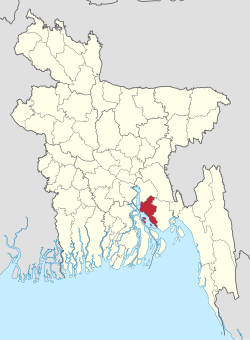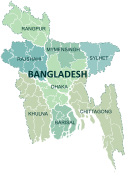Lakshmipur District
This article needs additional citations for verification. (March 2013) |
Lakshmipur District
লক্ষ্মীপুর জেলা | |
|---|---|
Road from Dhaka to Lakshmipur, Tita Khan Jame Masjid, Dam near Moju Chowdhury Hat, Meghna River at Haidergang Ghat, Sunset at Char Alexander | |
 | |
 Expandable map of Lakshmipur District | |
| Coordinates: 22°57′00″N 90°49′30″E / 22.9500°N 90.8250°E | |
| Country | |
| Division | Chittagong Division |
| Subdivision | 1979 |
| District | 15 February 1984 (split from Noakhali) |
| Headquarters | Lakshmipur |
| Government | |
| • Deputy Commissioner | Muhammad Anwar Husayn Akand |
| Area | |
• Total | 1,440.39 km2 (556.14 sq mi) |
| Population | |
• Total | 1,937,948 |
| • Density | 1,300/km2 (3,500/sq mi) |
| Demonym(s) | Lakshmipuri, Laxmipuri |
| Time zone | UTC+06:00 (BST) |
| Postal code | 3700 |
| Area code | 0381 |
| ISO 3166 code | BD-31 |
| HDI (2018) | 0.596[2] medium · 11th of 21 |
| Website | www |
Lakshmipur District (Bengali: লক্ষ্মীপুর জেলা; Bengali pronunciation: [lokʰːiˈpur]) is a district in Bangladesh with an area of 1,440 km2. It is bordered by Chandpur to the north, Bhola and Noakhali districts to the south, Noakhali to the east, and Barisal and Bhola districts to the west. Lakshmipur was part of Noakhali until 15 February 1984, when the western part of Noakhali was reorganised from Lakshmipur subdivision into Lakshmipur district to improve administrative efficiency.[3]
History
[edit]As with the rest of the erstwhile Noakhali district, most of the Lakshmipur area was formed relatively recently from alluvial deposits brought by the Meghna. The region was formerly under the Samatata region of ancient Bengal and later formed part of the Bhulua Kingdom, which intermittently fell under the domination of the Bengal Sultans, Tripura and Rakhine. During the 14th century, a Sufi saint called by the locals Shah Miran arrived in the district to spread Islam among the local Hindus. His dargah is in Kanchanpur village of Ramganj Upazila.
Bhulua was conquered by the Mughals in the early 17th century. In the 18th century, the East India Company took over the region and formed the district of Noakhali. The Noakhali riots began in Shyampur village of Ramganj Upazila and spread to the rest of the present district. After Partition, Lakshmipur continued to be a part of Noakhali district until 1984 when it became its own district.
Geography
[edit]Lakshmipur is roughly triangular in shape. It borders Chandpur district to the north, Noakhali district to the east, and Barisal and Bhola districts across the Meghna to the southwest. The southwestern portion of the district consists of chars formed by alluvial deposits of the Meghna, which are constantly shifting in position and size. There are very few major rivers, the two biggest being the Meghna and Dakatia. The Meghna forms the southwestern border of the district and is very wide.
The chars in the Meghna are made up of alluvial deposits that, after a few months, begin growing grass and trees and become suitable for cultivation. Most of present-day Lakshmipur district was created in the last century by the gradual merging of chars with the mainland. The terrain is flat and is mostly cultivated fields with pockets of forest cover.
Administration
[edit]The district of Lakshmipur consists of four municipalities, 58 union parishads, 514 villages, 3,539 mosques, 45 temples, and one church.[4]
The upazilas or subdivisions under this district are:[5]
Police stations
[edit]There are six police stations in Lakshmipur.
- Lakshmipur Model Thana
- Ramganj Thana
- Raipur Thana
- Ramgati Thana
- Kamalnagar Thana
- Chandragonj Thana
Demographics
[edit]| Year | Pop. | ±% p.a. |
|---|---|---|
| 1974 | 966,785 | — |
| 1981 | 1,120,260 | +2.13% |
| 1991 | 1,312,337 | +1.60% |
| 2001 | 1,489,901 | +1.28% |
| 2011 | 1,729,188 | +1.50% |
| 2022 | 1,937,948 | +1.04% |
| Sources:[1][6] | ||
According to the 2022 Census of Bangladesh, Lakshmipur District had 459,344 households and a population of 1,937,948 with an average 4.16 people per household. Among the population, 431,467 (22.26%) inhabitants were under 10 years of age. The population density was 1,345 people per km². The literacy rate (age 7 and over) in Lakshmipur was 73.98%, compared to the national average of 74.80%, and the sex ratio was 1,122 females per 1,000 males. Approximately, 24.90% of the population lived in urban areas. The ethnic population was 150.[1]
| Religion | 1941[7]: 102–103 [a] | 1981[6] | 1991[6] | 2001[6] | 2011[6] | 2022[1] | ||||||
|---|---|---|---|---|---|---|---|---|---|---|---|---|
| Pop. | % | Pop. | % | Pop. | % | Pop. | % | Pop. | % | Pop. | % | |
| Islam |
515,846 | 85.65% | 1,056,203 | 94.28% | 1,250,433 | 95.28% | 1,431,870 | 96.11% | 1,669,495 | 96.55% | 1,875,790 | 96.79% |
| Hinduism |
86,400 | 14.34% | 63,690 | 5.69% | 61,196 | 4.66% | 57,682 | 3.87% | 59,417 | 3.44% | 61,846 | 3.19% |
| Others[b] | 60 | 0.01% | 367 | 0.03% | 708 | 0.06% | 349 | 0.02% | 276 | 0.01% | 312 | 0.02% |
| Total population | 602,306 | 100% | 1,120,260 | 100% | 1,312,337 | 100% | 1,489,901 | 100% | 1,729,188 | 100% | 1,937,948 | 100% |
As of the 2011 census, 96.55% of the population were Muslims and 3.44% were Hindus. The Hindu population decreased slightly from 64,000 in 1981 to 59,000 in 2011,[6] but increased to 62,000 in 2022.[1]

Education
[edit]- Lakshmipur Government College (The highest educational institution for higher studies in the district)
- Lakshmipur Adarsha Samad Government High School (Known as District High School of Lakshmipur)
Notable people
[edit]This article's list of residents may not follow Wikipedia's verifiability policy. (December 2022) |
- Mohammad Mohammadullah, 3rd President of Bangladesh[8]
- Nishat Majumdar, first Bangladeshi woman to climb Mount Everest[9]
- Abdul Matin Chowdhury, 14th vice-chancellor of the University of Dhaka[10]
- A. N. M. Momtaz Uddin Choudhury, first vice-chancellor of Islamic University, Bangladesh
- Abdul Mannan, MP for Lakshmipur-4
- Abul Khair Bhuiyan, former MP for Lakshmipur-2
- A.K.M. Shahjahan Kamal, former Minister of Civil Aviation and Tourism
- A. N. M. Shamsul Islam, former MP for Lakshmipur-1
- A. S. M. Abdur Rab, politician and founder of the Jatiya Samajtantrik Dal-JSD
- Chowdhury Khurshid Alam, former MP for Lakshmipur-2
- Gholam Sarwar Husseini, politician and former Pir of Dayra Sharif, Shyampur
- Hafezzi Huzur, founder of the Bangladesh Khilafat Andolan
- Harunur Rashid, former MP for Lakshmipur-2
- Husne Ara Shahed, author and writer
- Khairul Enam, former MP for Lakshmipur-3
- M. A. Awal, former MP for Lakshmipur-1
- Mohammad Noman, Jatiya Party politician
- Mohammad Shahid Islam, MP for Lakshmipur-2
- Mohammad Toaha, activist in the Bengali Language Movement and politician
- M. M. Ruhul Amin, 16th Chief Justice of Bangladesh
- Muhammad Abdullah, academic
- Nazim Uddin Ahmed, former MP for Lakshmipur-1
- Selina Parvin, journalist and poet
- Shahiduddin Chowdhury Annie, former MP for Lakshmipur-3
- S. I. M. Nurunnabi Khan, writer and freedom fighter
- Syed Abul Kalam Azad, former treasurer of the University of Dhaka
- Tofail Ahmed, folk researcher
- Tufail Mohammad, Punjabi military officer and second recipient of the Nishan-e-Haider
- Ziaul Haque Zia, former MP for Lakshmipur-1
Notes
[edit]- ^ 1941 figures use Ramganj, Raipur, Lakshmipur and Ramgati thanas of erstwhile Noakhali district. District and thana (now Upazila) borders have shifted slightly since. As Ramganj was divided into Ramganj and Chatkhil upazilas in 1984, current population ratios have been used to estimate the 1941 population of the current Chatkhil upazila and religious distributions inside thanas were assumed to be homogenous.
- ^ Including Christianity, Buddhism, or not stated
References
[edit]- ^ a b c d e f Population and Housing Census 2022 National Report (PDF). Vol. 1. Bangladesh Bureau of Statistics. November 2023. pp. 149–151, 179–181, 191–192, 407.
- ^ "Sub-national HDI - Area Database - Global Data Lab". Retrieved 18 March 2020.
- ^ Sirajul Islam; Miah, Sajahan; Khanam, Mahfuza; Ahmed, Sabbir, eds. (2012). "Lakshmipur District". Banglapedia: the National Encyclopedia of Bangladesh (Online ed.). Dhaka, Bangladesh: Banglapedia Trust, Asiatic Society of Bangladesh. ISBN 984-32-0576-6. OCLC 52727562. OL 30677644M. Retrieved 25 January 2025.
- ^ লক্ষ্মীপুর জেলা তথ্য বাতায়নে আপনাকে স্বাগতম (in Bengali). Office of the Deputy Commissioner, Lakshmipur. Archived from the original on 23 August 2011. Retrieved 14 February 2012.
- ^ Md. Shajahan (2012). "Lakshmipur District". In Sirajul Islam; Miah, Sajahan; Khanam, Mahfuza; Ahmed, Sabbir (eds.). Banglapedia: the National Encyclopedia of Bangladesh (Online ed.). Dhaka, Bangladesh: Banglapedia Trust, Asiatic Society of Bangladesh. ISBN 984-32-0576-6. OCLC 52727562. OL 30677644M. Retrieved 25 January 2025.
- ^ a b c d e f "Bangladesh Population and Housing Census 2011 Zila Report – Lakshmipur" (PDF). Bangladesh Bureau of Statistics.
- ^ Bengal. Part II. Tables. Census of India, 1941. Vol. IV. The Manager of Publications, Delhi. 1942.
- ^ Sirajul Islam; Miah, Sajahan; Khanam, Mahfuza; Ahmed, Sabbir, eds. (2012). "Mohammadullah, Mohammad". Banglapedia: the National Encyclopedia of Bangladesh (Online ed.). Dhaka, Bangladesh: Banglapedia Trust, Asiatic Society of Bangladesh. ISBN 984-32-0576-6. OCLC 52727562. OL 30677644M. Retrieved 25 January 2025.
- ^ "First Bangladeshi woman on Everest". The Daily Star. 20 May 2012. Retrieved 9 November 2023.
- ^ Sirajul Islam; Miah, Sajahan; Khanam, Mahfuza; Ahmed, Sabbir, eds. (2012). "Chowdhury, Abdul Matin". Banglapedia: the National Encyclopedia of Bangladesh (Online ed.). Dhaka, Bangladesh: Banglapedia Trust, Asiatic Society of Bangladesh. ISBN 984-32-0576-6. OCLC 52727562. OL 30677644M. Retrieved 25 January 2025.
See Also
[edit]External links
[edit] Media related to Lakshmipur District at Wikimedia Commons
Media related to Lakshmipur District at Wikimedia Commons Lakshmipur District travel guide from Wikivoyage
Lakshmipur District travel guide from Wikivoyage Works related to Lakshmipur District at Wikisource
Works related to Lakshmipur District at Wikisource- official website LPDC






